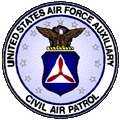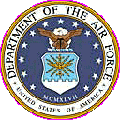
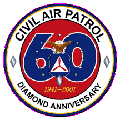
|
Just a little personal note from the designer of this web site before we start on our history lesson here. I researched all the Civil Air Patrol information on the Internet and through CAP pamphlets, that are handed out to the general public. There were countless sights that I picked notes up from and much help came from the leaders and cadets from Squadron 184 to help fill in the facts although the design itself is totally mine. Many nights I had been up till 3 or even 5 A.M. just reading and taking notes to make sure I didn't miss out, misrepresent, or repeat myself here. I thoroughly enjoyed myself creating this site. I learned so much history doing these pages and can fully understand and appreciate the pride that the Civil Air Patrol takes in its country, in its organizational leaders, and in its members.
If you have any more information that would benefit this History of the Civil Air Patrol web site please E-Mail me the information.
|
|
|
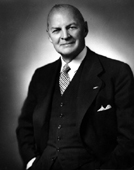 Gill Robb Wilson
Gill Robb Wilson
Civil Air Patrol was conceived in the late 1930's by legendary New Jersey aviation advocate Gill Robb Wilson, who foresaw aviation's role in war and general aviation's potential to supplement unprepared military. Wilson, then aviation editor of The New York Herald Tribune and later NJ Aeronautics Commissioner, first sold the idea to New Jersey's governor, who created a statewide organization. Wilson then convinced New York mayor of the need for a civilian air defense organization. First organized under the Office of Civilian Defense, headed by former New York Mayor Fiorello LaGuardia, Civil Air Patrol members became the "Minutemen" of World War II, volunteering their time, resources, and talents to defend the nation's borders and fill the gaps as men and resources were being mobilized to fight abroad.
In the late 1930's, more than 150,000 volunteers with love for aviation argued for an organization to put their fabric-covered planes, sometimes called "puddle-jumpers", and flying skills to use in defense of their country. As a result, the Civil Air Patrol was born one week prior to the Japanese attack on Pearl Harbor. Thousands of volunteer members answered America's call to national service and sacrifice by accepting and performing critical wartime missions.
On a mission day they usually took off early in the morning from a dew-covered grass field (usually built by and for CAP, and guarded by them also) and flew into the rising sun (East) and out some 50 miles off the coast and over the foreboding Atlantic Ocean, then patrolled until it was necessary to fly back now into the setting sun (West). Now came the hard part - landing a plane - and with bone weariness of a long flight time. Besides testing their endurance, and above all kidneys... and remembering also that they might be still be carrying a bomb or torpedo held on by bailing wire, spit and prayers.
CAP initially planned only on liaison flying and interdiction of infiltrators on the East Coast and the southern boarder, but CAP's mission grew when German submarines began to prey on American ships. One time, a CAP pilot saw a submarine cruising inside the shallow water area, but the sub paid no attention to the harmless little plane overhead. The CAP pilot said he flew low enough "to throw a rock or a wrench and hit the submarine", yet the U-boat in shallow water went moving along just like a cabin cruiser. When it was ready, the sub went out through a gap in the shoals and sank one of our ships. Around May 1942 a Nazi submarine was spotted "stuck" in the sand in shallow water offshore of Cape Canaveral, FL. The observers radioed West Palm Beach base to contact any military base to dispatch a bomber. Several bases were called but there were no available bombs or bombers. Unfortunately, the United States was caught unprepared. Most of the military aircraft were in Europe and Africa fighting the Germans or else in the Pacific fighting the Japanese. Finally, after several hours of extensive searching, a bomber was located at Jacksonville Naval Air Station that was equipped with depth charges. By the time the Navy Bomber arrived the sub had freed itself and returned to the Atlantic Ocean.
To say the least there were many military and civilians that were furious to think that a submarine "stuck" in the sand - right on our own shores - was able to escape because of a lack of insight and fire-power. After General "Hap" Arnold, the National Commander of the U.S. Army Air Forces heard of what happened he started screaming orders "start getting those little Civil Air Patrol planes armed with bombs, even if you have to throw the damned bombs out of the WINDOWS!"
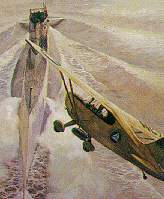
U-boat commanders cursed
the persistent presence of
what they called
the "YELLOW BEES".
"It vos dose gottdamned leetle
red
and yellow airplanes" |
|
|
The newly organized National Civil Air Patrol headquarters was in a quandary. How were they to hang bombs on small three and four place civilian aircraft with such frail airframes? Civil Aeronautics Administration Airworthiness inspectors were given the task of figuring out this dilemma. Some of the problems encountered was trying to figure out how much stress the frames could take with bombs that were each around 50 to 100 pounds but with engines that only had 90 horsepower to haul them. To make matters worse there were several different styles and manufactures of planes so there was not going to be any "standard" method. Three-place Stinson Voyagers and a Rearwin were to carry one 100 pound demolition bombs, four-place Fairchilds were to carry two 100 pound bombs and Stinson Reliants were fitted with 100 pound depth charges. To give you an idea of how thing got complicated the depth charges needed to have their bottom fin sawed off to be able to clear the runway for take-off and landings. Here is how many of the bombs and depth charges were "Jimmy-Rigged"; two lengths of bailing wire (Yep, I typed "bailing wire") were attached to the bombs/depth charges. The wire came up through the floor, and two handle grips were attached. One was color coded yellow and the other was red. The "observer" pulled the red handle grip and the arming pin was pulled then the yellow handle grip was pulled to drop the device. It has been said that the U-boats disappeared in direct proportion to the spread of CAP operations. And that the unexpected appearance of "fleets of civilian aircraft" as the main hazard which forced the U-boats out of our coastal waters.
Assigned to the War department under the jurisdiction of the Army Air Corp, the contributions of Civil Air Patrol were uncanny. Unfortunately most wings and squadrons dutifully destroyed all records after 2-3 years as suggested in regulations of that time. After eighteen months of anti-submarine patrolling by the Civil Air Patrol, the military had enough planes built to take over all anti-submarine operations. Before CAP volunteers had finished their task in the war, they had flown more than 24 million miles, logging more than 500,000 flying hours, mostly in single-engine, small land planes. During their anti-submarine reconnaissance they found themselves well out over the oceanfinding 173 submarines, attacked 57, hit 10 and sank two, and summoned aid for 91 ships in distress and for 363 survivors of submarine attacks. They also performed other tasks. They flew courier service; they towed targets for antiaircraft batteries; they tracked for searchlight crews; and they flew sentry duty along the Mexican border looking for spies. They spotted forest fires and helped put them out; they were used in time of emergency when there were floods or other disasters; they located one lost plane after another in mountainous and wooded terrain. In addition to all this, they furnished a reservoir of cadets and enlisted men for the Army Air Forces. CAP pilots who had flown over 300 hours on ocean coastal patrol were eventually awarded
U.S. Army Air Force Air Medals.
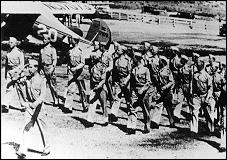
On April 29, 1943, by Presidential Executive Order, CAP became an auxiliary of the Army Air Forces. The military had resisted "those country-club pilots" and their "toy planes," but 21 CAP Coastal Patrol bases from Maine to Texas had soon deterred close-in submarine operations. By August 31, 1943, it was time for the Coastal Patrol to stand down. On July 1, 1946, President Harry Truman signed Public Law 476 incorporating Civil Air Patrol as a benevolent, nonprofit organization. After the war, a thankful nation understood that Civil Air Patrol could continue providing valuable services to both local and national agencies. On May 26, 1948, Congress passed Public Law 557 permanently establishing Civil Air Patrol as the auxiliary of the new U.S. Air Force.
Three primary missions areas were set forth at that time:
- COASTAL PATROL
America entered the war with meager maritime defenses on the East Coast. Gasoline and oil shortages grew and vital war supplies for Europe were nearly choked off as enemy subs operated with impunity - often within sight of our own beaches. Tankers and freighters were going to the bottom in record numbers. While the American military frantically geared up to meet the threat, ships were torpedoed in the mouth of the Connecticut River and in the Saint Lawrence. One surfaced sub actually motored right into outer New York harbor on January 15, navigating by reference to a New York City tourist map and visible landmarks like the Ferris wheel at Coney Island. Submarines could blast their prey at night as targets became silhouetted against still brightly lit coastal resorts. Usually unopposed, they could attack on the surface using deck guns to conserve torpedoes. Even years later, New Jersey teens termed their secluded romantic interludes on the beach as, "Watching The Submarine Races".
As tankers burned, Philadelphia-based Sun Oil (Sunoco), along with other concerned companies, established a "Tanker Protection Fund" to establish civilian coastal patrol bases until government financial support caught up. Volunteers came from everywhere and within months, some 40,000 signed up, ranging from over-aged World War I filers to aviation heroes and Hollywood celebrities.
CAP pilots provided their own airplanes and equipment, and often couldn't cover expenses on their $8.00 per flying-day government pay, which often arrived two months late. Civic organizations across the nation chipped in with "Sink-a-Sub" clubs, staging fund raisers for Coastal Patrol.
The military required an initial 90-day trial in early 1942 to prove civilians could do the job, so Coastal Patrol began as an experiment at three "hot-spots" of the submarine bloodbath: Atlantic City, New Jersey; Rehoboth Beach, Delaware; and Lantana, Florida. Flying up to 200 miles offshore were pilots whose previous over water experience had been crossing the wide part of the Delaware River from below Wilmington over to the South Jersey side. They wore military uniforms and "U.S." insignia so they would be prisoners of war if captured instead of being shot as guerrillas.
Atlantic City's initial flight was out only 15 minutes when it spotted its first torpedoed tanker and started coordinating rescue efforts. The presence of CAP raised tanker crew morale during the war and was even credited with convincing torpedoed tanker men to accept another assignment back at sea. A CAP crew first interrupted a submarine attack on a flight out of Rehoboth Beach, saving a tanker off Cape May, New Jersey. Since radio calls for military bombers were often unproductive, unarmed CAP fliers dived in mock attacks to force submarines to break and run.
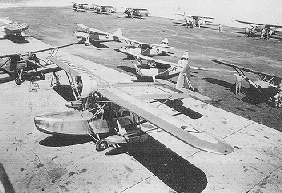
Many CAP aviators earned membership in the "Duck Club" for their numerous engine failures and subsequent ditchings at sea. Radio calls to CAP's communications network, if made in time on weak one-watt sets, brought CAP twin-engine Grumman Widgeon amphibians to the rescue. The first Air Medals of World War II presented in person by President Roosevelt went to CAP pilots Eddie Edwards and Hugh Sharp for one such rescue, which saved one of two crewmembers down in a bitterly cold wintertime ditching.
The year was 1942 at Rehoboth Airport and Maj. Hugh Sharp and Lt. Eddie Edwards were sitting in the operations shack when a distress call came in. Twenty miles off the coast of Delaware an airplane was down. Waves whipping up from a northeast wind were bigger than Sharp had imagined and almost caused the amphibian aircraft, he was piloting, to wreck when he set her down in the water. The right port wing float was damaged in the landing, causing the plane to list heavily to the left. Edwards climbed out onto the hull to look for the survivor and to get ready for the rescue. He spotted the pilot, Lt. Henry Cross, and tossed him a rope, however, Cross made no attempt to grab it. “Looks like he’s paralyzed – probably his back!” Edwards shouted back to Sharp. Sharp responded by carefully maneuvering the lopsided plane directly along side the injured survivor. Edwards reached out and slowly lifted Cross out of the water. The fierce seas and damaged wing made it difficult to take off; therefore, Edwards crawled out onto the right wing and clung there, his weight throwing the plane back into balance again. A half-frozen Edwards clung there for 11 hours as the un-flyable Widgeon was water taxied all night to shore.

Pres. Roosevelt awards air medal to Maj. Hugh R. Sharp
(center), and Lt. Edmond Edwards (right) for their heroic sea
rescue of Coastal Patrol pilot Henry Cross. Looking on is
James M. Landis, wartime chief of the Office of Civil Defense.
- OTHER WARTIME MISSIONS
CAP went on to target towing operations, courier service for the Army, liaison and cargo flights between war plants, Southern Border patrol against enemy infiltrators crossing from Mexico, and air search-and-rescue for many military planes that had gone down on training or ferry missions around the United States. After a B-52 crash landed one winter atop Mount Baldy near Taos, New Mexico, a CAP Taylorcraft made six successful landings at 12,800 feet to deliver survival rations and recover crucial equipment. Nevada CAP actually had its own cavalry of sorts, conducting ground rescue operations in rough territory on horseback, including 24 mounts transferred from the Army's now-obsolete Cavalry at Ft. Riley, Kansas.
Inland operations were typified by flying of Liaison Pilot Bill "Pappy" Madsen, operations officer for the "Mountain Boys" flying from Peterson Field in Colorado Springs, Colorado. CAP's operations in the Rockies actually pioneered many routes and mountain flying concepts still in use today. Colorado-based courier pilots operated 100 scheduled flights a day in the mountains of the West, with a like number perishing in the East on flights between war plants.
Women were actively recruited by CAP. In addition to support duties at Coastal Patrol bases, women pilots flew inland liaison, forest fire patrol and other missions. By war's end, women made up 20% of the Civil Air Patrol. These women were not immune to duty's dangers. Margaret Bartholomew, commander of the Cincinnati courier station, was lost in the western Pennsylvania mountains after departing Williamsport, unaware of a surprise storm ahead. Departing just as new weather information reached Williamsport, Bartholomew did not hear the tower's desperate attempts to recall her flight.
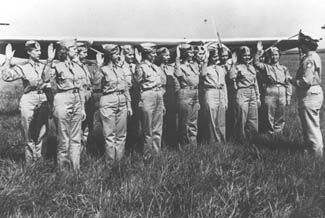
Civil Air Patrol's first female unit
The CAP efforts in WWII were not without sacrifice. During anti-submarine patrol operations alone, CAP lost 90 airplanes and 64 CAP aviators lost their lives. In all, Civil Air Patrol flew a half-million hours during World War II
CAP's role after the war was much in question, and it was widely expected to fade away along with most other wartime institutions. But military and political leaders rose to praise CAP's unusual commitment and accomplishment. At a special dinner in Washington, DC in March 1946, then President Harry Truman, Speaker of the House, Sam Rayburn, and no less than 300 members of Congress and 50 AF generals gathered to praise its work. President Truman later signed a bill granting CAP a national charter, placing the organization in a unique status similar to the American Red Cross. The United States Air Force was created as an independent armed service in September, 1947, and the Civil Air Patrol was permanently designated as its official auxiliary the following year.
- THE PEACE TIME CAP
Since air search-and-rescue had been one of CAP’s primary missions during the war, it was obvious there was no other organization with the equipment and training to continue this vital job in the post-war years. Even though there were plenty of military aircraft available, they cost far too much to operate and flew too fast for accurate spotting of downed planes and personnel. Military pilots were expensive to train as well, and mission requirements limited their availability for search-and-rescue work. Civil Air Patrol, with its proven record of volunteer service using light aircraft, was put to work.
By 1954, CAP was flying over 50 percent of the search-and-rescue hours flown in the country and according to the Air Force Air Rescue Service, was saving the country $46 million a year--the cost equal to the military and flight pay of the 12,000 fliers that would have been needed to fly the missions had CAP not been available.
In October 1954, Navy pilot Joe Meder became one of the many crash survivors who owe their lives to CAP. Flying at night at 40,000 feet in stormy skies, he was forced to eject from his burning Banshee jet fighter. Falling almost 30,000 feet as he wrestled with his ejection seat, he was able to separate from it and get his parachute open, only to have it rip and begin to lose air. He slammed into the ground, breaking both ankles and numerous other bones, and puncturing a lung. He crawled 150 feet before collapsing in a rain drenched bean field. Nearing death, Meder was spotted at first light by CAP pilots Vince Causmaker and John Zonge who were part of a two-state air and ground search team. When floods ravaged Kentucky, Virginia and West Virginia in 1957, CAP ground, air and radio teams swung into action. CAP planes flew vital serum and vaccines to forward areas unreachable by heavier military aircraft. Ground teams helped in the evacuation of cities and towns. In the Hazard, Kentucky area, the CAP radio network handled most of the traffic for the emergency agencies, coordinated the activities of Army rescue helicopters, controlled CAP activities in the area, and broadcast weather advisories from the U.S. Weather Bureau.
By the 1960s and ‘70s, CAP was logging over 75 percent of the search-and-rescue hours flown each year. The escalating civil aircraft fleet was the primary drive for the continued need for a growing CAP organization, but the CAP’s parent organization, the U.S. Air Force, sometimes had to use Civil Air Patrol’s search-and-rescue skills as well. When an F-111 fighter-bomber went down in the southwest, CAP members from six states were called up in a 15 day search-and-rescue operation. CAP pilots flew over 80 percent of the 1,400 sorties flown.
On May 18, 1980, Mt. St. Helens in Washington exploded, devastating approximately 150 square miles and triggering massive mud flows, floods and ash falls. When the county sheriff asked the Civil Air Patrol for help, CAP members were quickly on the scene, establishing a 24 hour headquarters, plotting leads, aiding search-and-rescue missions, and updating weather advisories. CAP teams assisted in several out-lying command centers and worked in ash cleanup crews.
 THE CAP INSIGNIA THE CAP INSIGNIA
The CAP insignia a red three-bladed propeller in the Civil Defense style (white-triangle-in-blue-circle), began appearing on private aircraft everywhere. (The red markings were later deleted for aircraft in combat areas to prevent confusion with enemy insignia.)
 CAP TODAY CAP TODAY
|
|
|
"THE BEST KEPT SECRET IN THE WORLD"
Few people realize
the dedication and commitment
of the volunteers of the Civil Air Patrol.
|
|
